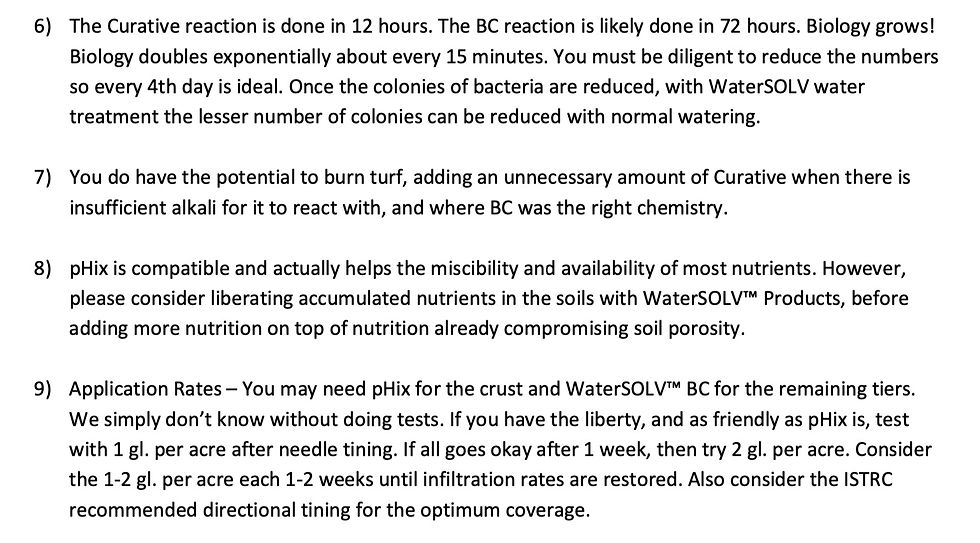Topical Applications of WaterSOLV™ Solutions
- Aug 23, 2022
- 3 min read
Apply WaterSOLV™ pHix or WaterSOLV™ BC, or WaterSOLV™ Custom Blend?
Before getting started; here are a few statements we have adopted about topically applying products.
Are these greens the members/ownerships that they hold us responsible for? It's always “Best to Test” in multiple like conditions. Areas with infiltration, and those without, can respond completely different.
“Prescription without diagnosis is mal-practice”. Let’s get the right analytical data and apply the right prescription so that we can realize the optimum results.
The right analytical data usually involves specific available nutrition and "Total" soil analysis, perhaps from varying areas and tiers as well. Ask about the Legacy Testing Methods.
Testing
Whether the greens are pushup, USGA sand based or other, odds are they have aged. Aging in greens is an accumulation of, or deterioration of matters within a soil profile. If you view the soil as a filter, it is likely more compromised by the accumulation and/or compaction at the surface layers, and perhaps biologically compromised in the lower layers due to reduced porosity and waters within the soil turning septic. Hence why flushing is important.
Naturally one looks at pore space by infiltration rate, moisture retention/percentage, ET, and yet bacteria can create toxic moisture as well as consume pore space and not show in any analytical data. No worries, we got this with you!

Yes, those images are about 100% clay and the best looking turf they'd ever seen. In calcareous scenarios, water and soil evaporative salts formed in the soils, other than those of sodium, zinc and manganese, are not dissolved by pure water or rain. Good water can flush soluble salts but it doesn’t dissolve complexes of beneficial cations and metals (Ca, P, K and Fe) other than zinc.
Let’s take one more step to look at some images from the link below. What we intend to show you from these images are the variety of soils we have delt with from a sponge cake bio-mess, to actual clay, the even caleche and black layer. If you think about it, we usually get the call when people are what we say, "at the end of the thread of the rope". View the images near the bottom of the page; https://www.hctllc.com/turf-shift
Getting Started
Start by identifying the problem(s). Is it cementation or biology, or perhaps both? Where is/are the problems? YOU help identify and collect the problem soil, perhaps at the 6 or 12 inch layer, perhaps at the surface. And the problem in one spot may act completely different than another and warrants its separate analysis. Do we take the soil sample horizontally or vertically? "Let's collect soil we see or suspect is the actual problem".
The right soil analysis method (The Legacy Method), will show us. Tiered soil analyses help us identify where the problems are located and how we can reach them effectively with the right medicine, and the right amount of medicine at the problematic “constraining” or toxic layer(s).
Take soil samples by tiers. We may be accustomed to taking samples by 4-inch tiers, but what we really want to do is take samples where we can identify or suspect the problems. The main problems we are looking for are;



Testing Methods
We have already proven the conventional testing methods have significant room for improvement and we’ve made those improvements. The changes result in more realistic “Available Nutrition” from your treated water onto your treated soil. The Exchangeable Nutrition has been dropped (the AA/DTPA and Mehlich III), to now look at the Total Digestion of the soil, which usually shows the mass number of nutritional cations and metals accumulated in the soils consuming porosity and hindering pore space, that we never saw in the data from the conventional testing methods. Both of these conventional method tests resulted in putting more nutrition on top of accumulated nutrition, hindering the essential needs of vegetation vitality, and without regards to infiltration, porosity and biological conditions.
The Necessities of Vegetation
Pore Space, Infiltration Rate, Moisture Penetration
Available Nutrition
H2O, Oxygen (water can turn septic)
Sodium & Chloride Detoxification
Remediation of Iron Bacteria bio-films
Remediation of Black Layer exudates including toxic H2S

Everything Comes at a Cost
But what about the value and savings? Take a look at the typical cost reductions which usually exceed the cost. https://www.hctllc.com/value-and-offset

Contact HCT directly for a list of qualified distributors, dealers, representatives, engineers, PCA's and CCA's.
HCT, LLC | info@hctllc.com (888) 788-5807 Making Water a Better Solution™ | Sustainable Chemistry & Biology to Water™ Well-Klean©, WaterSOLV™, Water Treatment for Agronomy™, Water pHix™ & WaterSOLV™ Grow are trade names of HCT, LLC Select products are accredited by NSF Standard 60, ANSI, Standards Council of Canada, and the California Department of Food & Agriculture























Comments